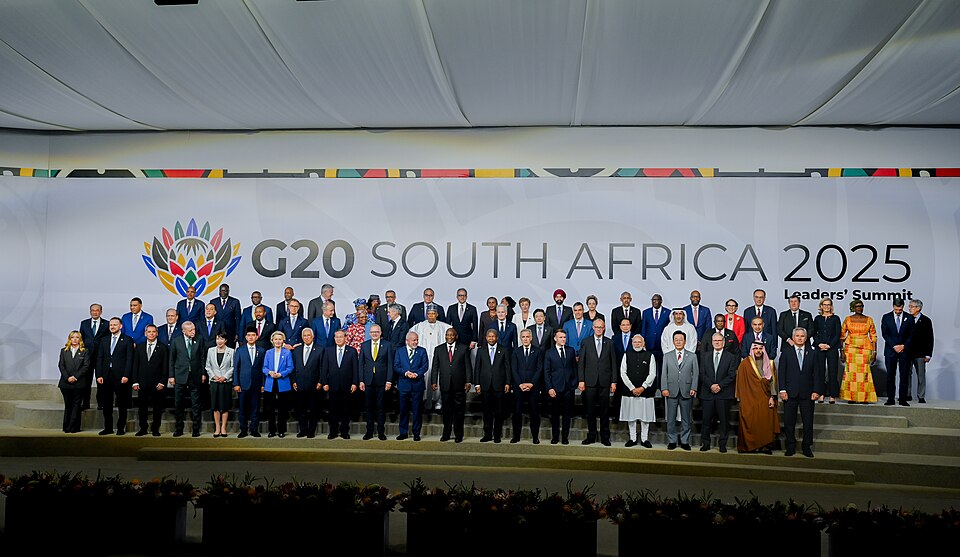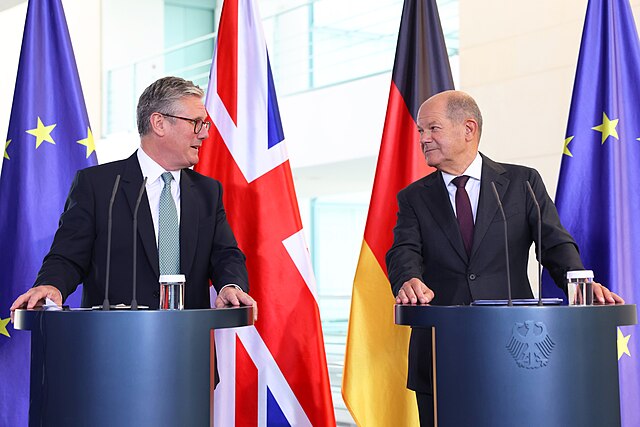You can read part one of this article here.
There is a basic tension in the role that tariffs are supposed to play. On the one hand, Trump is claiming that a host of countries are placing unfair tariff and non-tariff blocks on American exports to those countries, giving them their trade surplus. This is somewhat inconsistent with the blanket 10% tariff imposed, whether or not the country has a trade surplus, and whether that trade surplus is the product of tariff barriers, or non-tariff ones. But this is where Trump’s claim that countries are willing to do a deal comes in. Some have claimed that the outcome of this deal-making process will end up being lower trade barriers worldwide, making the tariffs only temporary.
There are two more justification for tariffs, however, which suggest they will be more permanent. The first is that they are essential to encourage inward investment, and to discourage investment from leaving the U.S. This is bound up with propaganda about making America great again by restoring its manufacturing base, an idea that also appeals to former manufacturing areas, like the so-called Rust Belt. But it also has a strong national security angle. Tariffs are justified by claiming that the US cannot be dependent on raw materials or vital areas of manufacturing on potentially hostile countries — in particular China, which has been an obsession of Trump’s (and, indeed, of every U.S. administration since Obama).
On top of that, Trump wants tariffs to raise money to enable him to continue cutting taxes for the rich. He has claimed that tariffs are already bringing in two billion dollars a day. We can take this claim with a pinch of salt; in any case, the tax take from tariffs will decline if the tariffs do their job of choking off imports. But Trump certainly needs to increase his tax take from somewhere if he is to keep or extend the tax cuts for the rich. The federal deficit is currently running at $1.9 trillion a year, or some 6.4% of total annual gross domestic product (GDP). And that is adding to American national debt, now at a staggering $36 trillion, or 120% of GDP.
Tariffs are a tax on imports. The intention of a tariff is to raise the price of the good and reduce demand for it as a consequence. If it doesn’t raise the price and reduce demand, it isn’t doing its job except as a money-raiser for the government. In raising the price and reducing demand, tariffs are therefore both potentially inflationary, raising the general price level, a phenomenon that will be more likely the more widespread the tariffs are. And they are also potentially recessionary, or bad for economic growth — by reducing demand for the goods of the exporting country, but also for the country imposing the tariffs, as rising import price inflation spreads through the economy. In other words, Trump’s tariffs portend a combination of the two — “stagflation”, or even “slumpflation”.
It might be hoped that tariffs would encourage inward investment, and discourage outward investment, and by doing so would boost the domestic economy, which could then start producing goods to substitute for what are now much more expensive imports. The problem with this is that it takes time to relocate production. The current globalised supply lines have been in the making for the past 80 years, in particular over the past 40 years of neoliberalism. They cannot be undone overnight. Further, companies like Apple depend on a highly skilled workforce. Such skilled workers are abundant in China and increasingly in India but not in the United States.
Moreover, investors — i.e., the rich — are now wary of the uncertainty that has been injected into the economy, both by the tariffs themselves and by Trump’s volatility. The rich don’t like this kind of uncertainty, and will therefore be more likely to hold off ploughing funds into long-term projects. The wealthiest 10% now also account for 50% of consumer spending in the United States, up from 36% thirty years ago. This is indicative of the fact that the rich have gotten much richer over the past 30 years, whilst incomes for many in the U.S. have stagnated or declined. The rich feel much richer when the shares in which they have invested rise in value. This wealth effect encourages them to spend. But the opposite happens when share prices fall. The reverse wealth effect curtails their consumption spending — meaning, of course, less demand in the economy, and less economic growth.
Those tens of millions of far less well-off Americans — whose spending makes up the other 50% of consumer spending in the United States — now face huge price rises in the goods that they have been purchasing from China (if they’re able to obtain them at all), and a loss of confidence in economic prospects. Those who can afford to put money into a savings account for a future pension have also been spooked by the loss of value in their pension pots, which have been heavily invested in the stock market. Add to this the effects of the sacking of tens of thousands of government employees by Musk and his so-called Department of Government Efficiency, and the deportation of undocumented migrants who contribute to the US economy — which, if successful, would lead to massive economic contraction.
What irks Trump, and those amongst his advisors who see neoliberalism as having been a disaster, is the phenomenal Chinese growth over the past 25 years, since China’s admission to the World Trade Organisation. That economic growth now threatens US imperial hegemony. It is ironic that Communist China is now the most enthusiastic defender of the virtues of “free trade” — and Capitalist Trump the most opposed to it!
China is certainly going to take a hit from the swinging tariffs Trump has imposed, but it seems to hold perhaps more cards than Trump does. U.S. agriculture is dependent on exports to China, and Chinese tech and rare-earth minerals remain vital to the U.S. China can switch exports to other markets — it is now the biggest player in international trade, with the U.S. considerably smaller. U.S. exports account for only 14% of total Chinese exports. On the other hand, the United States has itself become more dependent upon international trade, which comprises 14% of the U.S. economy.
The likelihood of a recession in the United States has very substantially increased, as the investment bank Goldman Sachs confirms. In such circumstances, the state has two weapons to try to improve the economic situation. The first of these involves spending more and taxing less. This is a fiscal stimulus. The other involves the central bank lowering interest rates, thus reducing borrowing costs. This is a monetary stimulus.
There are two problems though in trying to mobilise these weapons to counter recession. The first is with a possible fiscal stimulus. The United States federal deficit stands at 6.4% of GDP and the total federal debt is 120% of GDP. This is twice the size of the fiscal deficit and national debt that was laid down as a European target in the EU Stability and Growth Pact, as long ago as 1997. It is also predicted to carry on rising, unless drastic action is taken. The danger is that if Trump decides to cut taxes and possibly increase spending, the financial markets may take fright again — bond prices may fall, and interest rates rise. That in itself may negate the effects of the fiscal stimulus. But it might also threaten a financial crash.
The safe haven status of US government bonds means a lower interest rate can still attract wealthy buyers. A loss of confidence in those bonds as a safe haven would almost certainly entail higher interest rates to the detriment of the US economy.Given the reaction of the bond markets to Trump’s Liberation Day tariffs, the Trump administration should be concerned that deciding to deliberately expand the fiscal deficit could lead to another bond rout — pushing up interest rates and exacerbating the recessionary forces.
That leaves the U.S. central bank — the Federal Reserve — as a potential source of monetary stimulus, through interest rate cuts. However, the Federal Reserve is committed to maintaining monetary stability. Jerome Powell, the chair of the Federal Reserve whom Trump appointed in his first term, is clearly currently very cautious about reducing interest rates, as he believes that the sheer scale of tariffs threatens a revival of inflation. Trump has now publicly demanded that interest rates be cut, and has said that Powell’s “termination” cannot come fast enough, exploring the possibility of sacking him. But any appearance that the Federal Reserve is coming under political control may yet again badly spook the financial markets. Central banks have generally acquired greater independence in the neoliberal era, precisely to reassure the markets that there is an unelected pro-banking authority at the heart of monetary policy.
The U.S. economy therefore seems caught between a rock and a hard place. There are both recessionary and inflationary pressures rising from Trump’s tariff fetish, and limited means with which the government or the Federal Reserve can avoid both recession and inflation.
The enormous U.S. fiscal deficit and accumulating national debt are themselves a symptom of a much wider debt problem in the world economy. The era of neoliberalism, with money free to chase profit wherever it could be obtained, and barriers to trade and the globalisation of production coming down, was supposed to produce higher levels of economic efficiency and growth. Debt was a crucial ingredient in promoting this globalisation, and can be benign, if growth is sufficient to ensure that debt obligations are met and repaid.
The problem was and is that growth has been inadequate to stop the burden of debt growing. There simply hasn’t been enough profit in the system, relative to investment, to generate the growth necessary to stabilise and manage the level of debt. Economic growth continued in the era of neoliberalism but only with ever increasing amounts of government, corporate and consumer debt. The overall level of debt across the world economy now stands at more than three times the total annual value of world production.
Not only has growth been too slow, but it has also been punctuated by serious financial crises — of which the worst so far was the Great Financial Crisis (GFC) of 2008, followed by the Covid crisis. After the GFC, central banks sought to introduce rules and regulations — for example on reserve requirements — to try to prevent another seizing up of the financial system, as after the collapse of Lehman Brothers. The regulated bank sector may be more secure as a result. But half of the money circulating in the financial markets is now handled by the so-called shadow banking sector, which lies outside the regulatory regime imposed upon registered banks.
Private equity companies, in particular, have been in the lead in growing the U.S. economy in the past few years, when it boasted significantly higher levels of growth than were being managed by the laggardly European Union. But that growth has been generated by a plethora of high-tech startups, and, it is suspected, loading companies with ultimately unsustainable debt, in order to make short-term profits for those private equity companies. As things stand, some 20% of companies in the United States have zombie status, barely able to cover their existing debts, but unable to take on new debt to expand their operations even if they wished to.
Trump will have been in office just 100 days as the 47th President of the United States on the 30th of April, the day before International Workers’ Day. In those hundred days, he has almost single-handedly delivered a series of profound shocks to an already fragile U.S. and world economy. Trump’s trade war with China is increasingly being posed as a military contest by the Trump administration. Tensions are likely to rise over access to rare earth minerals — for example in the Congo — and other areas such as Taiwan, which produces advanced semiconductor chip, with the possibility of trade war leading to real war.
We live in turbulent and dangerous times. Never has there been a greater need for a genuinely socialist alternative to this endemically crisis-ridden and exploitative capitalist world economy.




